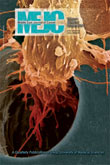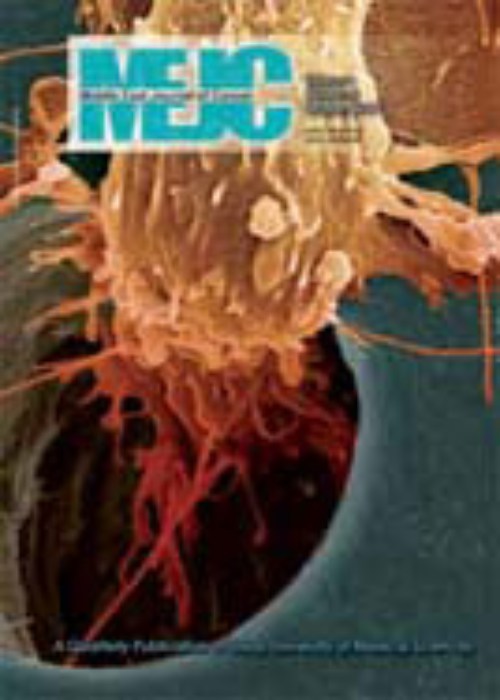فهرست مطالب

Middle East Journal of Cancer
Volume:8 Issue: 2, Apr 2017
- تاریخ انتشار: 1396/01/06
- تعداد عناوین: 9
-
-
Pages 65-68Although there is evidence that vitamin D deficiency leads to the development of several cancers, including colorectal cancer, research has shown gaps in establishing a relationship between hypovitaminosis D and the incidence of colorectal cancer.
There are controversial reports and inadequate scientific evidence about the role of age and race-specific dosage of vitamin D supplementation for chemoprevention. This editorial sheds light on the current evidence on the association of vitamin D deficiency and colorectal cancer, the role of vitamin D supplementation, and the future action plans to establish the needs analysis and goal setting about this area of research.Keywords: Colorectal cancer_Vitamin D_Apoptosis_Vitamin D supplementation_Chemoprevention -
Pages 69-75BackgroundBreast cancer is one of the most common cancers in the world, particularly in Iran. There are many genomic and molecular factors that cause the occurrence of breast cancer. Many markers are associated with tumor invasiveness. Matrix metalloproteinase includes a family of zinc-dependent endopeptidases that degrade various components of the extracellular matrix and basement membrane. Matrix metalloproteinase expressions increase in thyroid, colorectal, head and neck squamous cell carcinoma, lung, and ovarian cancers. It is correlated with tumor angiogenesis, invasion, and metastasis. Matrix metalloproteinase 11 is a member of the stromelysin subclass of the matrix metalloproteinase family. This enzyme is secreted to become a potentially active form against other matrix metalloproteinases. Contradictory results exist regarding the correlation between matrix metalloproteinase 11 expression and clinicopathologic parameters in breast cancer.MethodsThis case-control study examined 80 invasive ductal carcinoma of the breast and 80 adjacent nonneoplastic breast tissue paraffin blocks to identify the relationship between matrix metalloproteinase 11 expression and clinicopathologic parameters such as age, tumor size, microscopic grade, perineural and vascular invasion, lymph node involvement, and stage by immunohistochemistry analysesResultsAmong the 80 patients, 86.3% showed matrix metalloproteinase 11 expression in tumor cells and 17.5% had matrix metalloproteinase 11 expression in adjacent normal breast tissue. This expression correlated with stage, grade, lymph node metastasis, and perineural and vascular invasion (P0.05).ConclusionMatrix metalloproteinase 11 expression is increased in breast cancer and may be used as a predictive factor for tumor invasiveness.Keywords: Invasive ductal breast carcinoma, MMP-11, Immunohistochemistry (IHC)
-
Pages 77-82BackgroundThis study aimed to assess several biochemical and oxidative stress parameters before and after radioiodine therapy in patients with well-differentiated thyroid cancer who consumed a low iodine diet and withdrawal of levothyroxine after total thyroidectomy.MethodsWe enrolled 40 candidates for radioiodine therapy. Blood sampling was performed prior to as well as 72 h after consumption of 125-200 mCi of 131I. Total protein, aspartate aminotransferase, alanine aminotransferase, alkaline phosphatase, and creatinine were measured. Oxidative stress parameters that included malondialdehyde and protein carbonyl levels were also assessed.ResultsThere were significantly decreased total protein, creatinine, aspartate aminotransferase, and alanine aminotransferase levels (PConclusionWe found that radioactive iodine absorption in peripheral tissues due to a low-iodine diet and levothyroxine withdrawal could relieve iodine deficiency in the liver and kidneys which resulted in reduced total protein, aspartate aminotransferase, alanine aminotransferase, and creatinine levels. However, it induced oxidative stress by increasing malondialdehyde levels in the blood.Keywords: Biochemical parameters, Oxidative stress, Well-differentiated thyroid cancer, Radioiodine therapy
-
Pages 83-91IntroductionMortality rate of breast cancer has been fallen in recent years. Combination of cyclophosphamide, methotrexate, and 5-fluorouracil(CMF), as a pioneer of adjuvant chemotherapy of breast cancer, and later introduced anthracycline/taxane(A/T)-based regimens have both produced favorable outcomes in early-stage breast cancer. The current study, aimed to evaluate the probably different outcomes between CMF and A/T regimens.MethodsIn this cohort study, we extracted medical records of 1098 breast cancer patients referred to some oncology centers of Mashhad University of Medical Sciences from 1370 to 1390. Invasive cancers on stages I and II candidate for systemic chemotherapy were included. We categorized patients in the CMF and A/T arms and considered median event free survival (EFS), median overall survival (OS), 5- and 10-year EFS, and 5- and 10-year OS as the endpoints of the study.ResultsIn the CMF arm, median EFS was 190 months and the 5 and 10-year EFS were 77% and 61% respectively, while in the A/T arm, median EFS was 212 months and 5 and 10-year EFS were 74% andConclusionSimilar effectiveness exists between CMF and A/T-based regimens regarding outcomes of adjuvant treatment for early-stage breast cancer. We could be confident that CMF is more favorable due to infrequent side effectsKeywords: Early stage breast cancer, Adjuvant chemotherapy, 5-fluorouracil (CMF)
-
Pages 93-101BackgroundBreast cancer is the most common type of cancer and second leading cause of death in women after lung cancer. The World Health Organization has reported that breast cancer, with 502,000 deaths in 2005, surpassed lung, stomach, colorectal, and cervical cancers as the leading cause of death in women. The main objective of the current study was to examine the predictive role of emotional selfregulation in quality of life and perception of suffering among patients with breast cancer.MethodsThis was a descriptive-analytical study followed by a correlational design. The sample population consisted of 42 patients with breast cancer selected by the census method. Participants completed questionnaires on emotional self-regulation, quality of life (Aaronson et al., 1987), and perception of suffering. The obtained data was statistically analyzed using the Pearson correlation coefficient and regression analysis via SPSS 22.ResultsThere was a significant, positive association between emotional selfregulation and the functional and general dimensions of quality of life. A significant, inverse correlation existed between emotional self-regulation and the symptoms dimension of quality of life. The results of the enter regression analysis showed that selfregulation respectively predicted 0.18 of variance in the functional, 0.26 in symptoms, and 0.37 of the variance in the general health dimensions of the quality of life. Emotional self-regulation had a significant, diverse relationship to the physical, psychological, and existential dimensions of perception of suffering. The results of the regression analysis carried out to predict perception of suffering indicated that emotional self-regulation respectively predicted 0.33 of variance in the physical, 0.19 in psychological, and 0.06 of the variance in the existential dimensions of perception of suffering.ConclusionA major step forward can be taken towards improving the level of quality of life among breast cancer patients through the use of books and educational brochures, individual and group counseling sessions associated with emotional self-regulation, and encouragement of patients to participate in cultural and sports activities.Keywords: Emotion, Quality of Life, Suffering, Breast Cancer
-
Pages 103-108BackgroundEsophageal cancer is the second most common malignancy in Iranian men and third most common in Iranian women.The aim of this study is to discover the geographic distribution for age-standardized incidence rate of esophageal cancer among both genders in Iran.MethodsThis ecological study used re-analysis medical records aggregated to provinces from the National Cancer Registry and Disease Control and Prevention Report of the Ministry of Health and Medical Education for esophageal cancer in 2008. For each province, we calculated the average annual age-standardized incidence rate.ResultsSquamous cell carcinoma was the most common histological type of esophageal cancer in males (65.4%) and females (75%). The age-standardized incidence rate for esophageal cancer in Western, Northwest, Northern and Northeast provinces of Iran were higher than other provinces. We observed the highest agestandardized incidence rate in both genders in the 80-84 year age group with 147.5 in males and 114.5 in females.ConclusionGiven that the Western, Northwest, Northern, and Northeast provinces were hot zones for esophageal cancer in Iran, increased access to screening services and implementation of prevention programs should be considered.Keywords: Esophagus cancer, Sex, age distribution, Incidence, Population-based study, Iran
-
Pages 109-112Renal masses can be categorized as benign and malignant lesions. Among the renal malignancies, renal cell carcinoma is the most common malignancy. However, other rare malignant lesions should be considered in differential diagnosis. Primary renal lymphoma is quite rare and might be mistaken for renal cell carcinoma. Due to lack of lymphatic tissue in the kidney, pathogenesis of renal lymphoma is controversial. In the present case, a 75- year-old man presented with a locally advanced renal mass and after resection of the mass, a diagnosis of Non-Hodgkins lymphoma was confirmed.Keywords: Non-Hodgkin's lymphoma, Renal mass, Primary renal lymphoma, Renal cancer
-
Pages 113-116Myxofibrosarcoma is a malignant neoplasm of connective tissue origin commonly found in the extremities. It is very rare in the head and neck regions. Only 25 cases of myxofibrosarcoma have been reported in the head and neck regions until 2014. Here we report a 61-year-old male with this neoplasm in the lower border of his mandible. During a two-year follow-up, this case recurred four times despite a complete resection. This study suggested combined surgical and adjuvant radiotherapy for unresectable lesions and tumors with positive margins to prevent recurrence and risk of progression.Keywords: Mandible, Myxofibrosarcoma
-
Calendar of EventsPage 117


